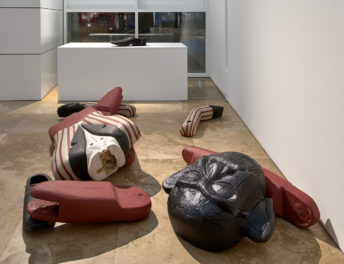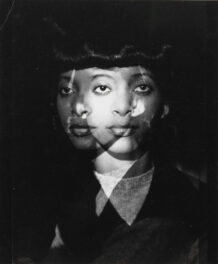
Cineramadome on Sunset Boulevard photographed by Ed Ruscha in 1973, 1990, and 2007, respectively. Streets of Los Angeles Archive. The Getty Research Institute, 2012.M.1. © Ed Ruscha
The Getty Research Institute launched today 12 Sunsets: Exploring Ed Ruscha’s Archive, an interactive website that allows users to discover thousands of photographs of Sunset Boulevard taken by artist Ed Ruscha between 1965 and 2007.
“Ed Ruscha’s engagement with the Los Angeles cityscape is profound. Since the mid-1960s he has taken more than a half-million photographs of the streets of Los Angeles, which have been at Getty Research Institute since 2012,” said Mary Miller, director of the Getty Research Institute. “We aim to activate this rich material and make it widely accessible and appealing to anyone interested in art or the recent history of this great city. The vast majority of these photographs have never been seen before, and making them accessible opens up new avenues for inquiry about one of the most significant artists of the postwar period, as well as a major part of Los Angeles history.”
The website, designed by Stamen Design working with Getty Digital, allows users to “drive” down Sunset Boulevard in 12 different years between 1965 and 2007, as well as to view, search, and compare the more than 65,000 photographs of this key urban artery. Entering this user-friendly website, visitors can navigate Sunset Boulevard in a particular year, browsing tens of thousands of geotagged photos, with images from both sides of the street. Users can search by address, explore how neighborhoods changed over the years, compare sites at different times, and search the images by words on signs or by subject – functions made possible by optical character recognition and computer vision.

A screenshot of 12 Sunsets, which features photos from the Streets of Los Angeles Archive. The Getty Research Institute, 2012.M.1. © Ed Ruscha. Website design by Stamen.
The photographs are part of the Ed Ruscha Streets of Los Angeles Archive, a trove of 500,000 photographs, notes, drawings, and records documenting the artist’s photography of Los Angeles which was acquired by the Research Institute in 2012.
“Through his street photography, Ed Ruscha created what is probably the most significant artistic record of a city in the United States and perhaps the world,” said Andrew Perchuk, deputy director of the Getty Research Institute. “This incredible body of work will be of interest not only to art lovers but to anyone interested in the vast social, demographic, and architectural changes Los Angeles has experienced over the last 50 years. 12 Sunsets is a user-friendly path into his practice, and is suitable for all ages.”
About the Streets of Los Angeles Archive

Ed Ruscha’s diagram for photographing while driving on a city street. From the Streets of Los Angeles Archive. The Getty Research Institute, 2012.M.1. © Ed Ruscha
In 1966, Ed Ruscha began a sweeping, systematic, and innovative effort to photograph the streets of Los Angeles to create his seminal artist book Every Building on the Sunset Strip (1966). Using a motorized camera mounted on the back of a pickup truck, he captured photographs of the buildings on each side of the street. Tracking distinctive elements of the Los Angeles cityscape, the project spans five decades and records major streets such as Hollywood Boulevard, Melrose Avenue, and Sunset Boulevard. The archive of this methodical and expansive effort contains more than a half-million images including negatives, digital files, contact sheets, notebooks, and the complete production archive of Every Building on the Sunset Strip. The Getty Research Institute acquired the Ed Ruscha Streets of Los Angeles Archive in 2012 and subsequently launched an ambitious project to digitize this material and make it widely accessible. 12 Sunsets is the first public element of this endeavor. Other aspects of digitization include four scholar teams who have been working with the GRI to create their own projects using the Streets of L.A. digital material and an upcoming digital publication to be created with Getty Publications.
About Ed Ruscha
Born in Omaha, Nebraska, in 1937, and raised in Oklahoma City, Ruscha moved to Los Angeles in 1956 to study at the Chouinard Art Institute (today’s California Institute of the Arts in Valencia). He began exhibiting with Ferus Gallery in Los Angeles in 1963 and Leo Castelli Gallery in New York in 1973 and is currently represented by Gagosian Gallery. His interest in typography, signage, and, more broadly, “the vernacular,” positions his work equally within the contexts of Pop art and Conceptual art.
Photography has played a crucial role throughout Ruscha’s career, beginning with images he made during a trip to Europe with his mother and brother in 1961, and most memorably as the imagery for more than a dozen books that present precisely what their titles describe, among them: Twentysix Gasoline Stations (1963), Various Small Fires and Milk (1964), Some Los Angeles Apartments (1965), Every Building on the Sunset Strip (1966), Thirtyfour Parking Lots in Los Angeles (1967), Nine Swimming Pools and a Broken Glass (1968), Real Estate Opportunities (1970), and A Few Palm Trees (1971).
Many of Ruscha’s self-published books reveal his interest in the architecture of his immediate environment. His photographs are straightforward, even deadpan, in their depiction of subjects that are not generally thought of as having aesthetic qualities. Mostly devoid of human presence, these photographs emphasize the essential form of the structure and its placement within the built environment. Several of the photographs that appeared in these publications became source material for works of art that Ruscha would realize in other media either at the same time or several years—even decades—later. He reinterpreted a number of photographs published in Some Los Angeles Apartments (1965) in a series of graphite drawings the same year. One of the most notable, however, is Ruscha’s sustained interest in the photograph of Standard Station, Amarillo, Texas that he took in 1962 and published in Twentysix Gasoline Stations the following year. Over the next four decades, he would create several works on canvas or paper that abstracted the original silhouette of the gas station, including the monumental 1963 oil painting with the same title.




When I was in 7th grade my dad was in the guided missle coprs and we got to love in some really nice places. (about 1986)
I knew about the garden, My ballet teachers were Velma and Helga Epsen-in addition to cooking for us, and teaching for us she talked about the stars. THey were quite elderly by then. I feel so lucky to have know them and been in their house and studio which is now an international school in Pacitic Palisades. Your work is terriffic.
Just discovered this site. Thank you!
When I click on the link ‘Explore 12 Sunsets here’ I get a blank page – nothing comes up.
I can’t get or see anything.
Thanks for any assistance.
Hi!
It should be working – here’s the full link if you want to cut and paste into your browser:
https://12sunsets.getty.edu/
Thanks!